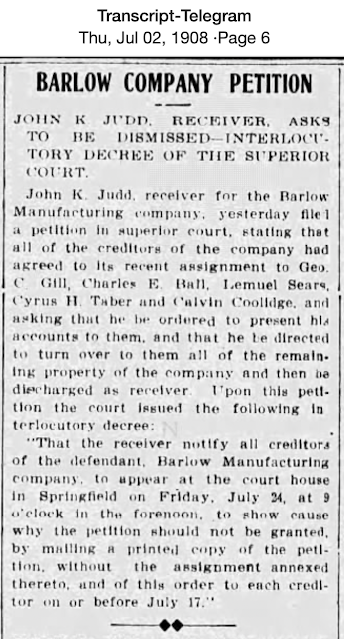In the 1890s, the country's population was growing, and retail operations were expanding rapidly. The Barlow Mfg. Co. manufactured modern store window display fixtures and showcases for retailers. The company used nickel, bronze, brass, and copper plating from its plant to enhance the product finishes. Its plating department was one of the largest in New England.
The Barlow Manufacturing Company was formed in 1894 in Boston and moved to Holyoke in 1896. It settled in the Whitcomb Building on Front Street.
The company expanded within the factory building when the Commercial Printing Company vacated to Race Street in 1900.
A 200-page catalogue was produced in 1900 to advertise its offerings to existing and prospective customers.
The company manufactured and installed brass fixtures in the Besse Mills Store and the Sutherland & Co., a Boston retailer. The cases were made of solid oak with glass tops and sides to give the customer a clear view of the contents. a novel approach for its time.
Within 6 months in mid-1901, its workforce doubled to 50 employees.
Needing more space, the company moved to the Cabot Street mill of the Holyoke Water Power Company in 1902. In 1905, the company produced 1,000 shoe stands for the Plant Manufacturing Company in Roxbury, Massachusetts, as an example of increased production.
With its five-year lease expiring, the company planned to move to its own factory on Winter Street, which was to be built by Casper Ranger Construction in early 1907. The plant would be four stories, with an ell addition on the first floor. Barlow Manufacturing would occupy the first three floors, with White & Wyckoff leasing the top floor.
The move from Cabot Street to Winter Street started at the end of June 1907. However, the company's extremely rapid growth came at a price. By year's end, the corporation fell into the hands of a Receiver, as it could not pay its debts. The options presented to the creditors included closing the corporation under the Receiver's control, 25% cash for each outstanding debt, or a new shareholder group to operate the business.
The latter option was chosen and approved by the court, and the new shareholders and officers included:
> George C. Gill, President, who had vast entrepreneurial skills and was President of Holyoke National Bank,
> Lemuel Sears, Treasurer, who owned Sears & Company, wholesale and retail grocers,
> Calvin Coolidge, Northampton lawyer and trustee of the Northampton Savings Bank,
> Cyrus H. Taber, who reorganized Ampad after an embezzlement that bankrupted the company, and
> Charles E. Ball, of C. E. Ball Drug Co. and Vice-President of Holyoke National Bank.
The Receivership ended in July 1908, and the factory building was turned over to Casper Ranger, subject to the outstanding mortgage.
The reorganized Barlow Manufacturing Company moved from its elaborate space on Winter Street and returned to Holyoke Water Power's Cabot Street mill complex as a cost-saving measure.
By August 1908, new orders for displays resumed. The company added to its services, including creating wax figures for store window displays and repairing automobile lamps in its plating department. George Gill was a creative force who understood the benefits of diversification.
In December 1908, the company and Grand Rapids Showcase Company of Grand Rapids, Michigan, the country's largest showcase and store equipment manufacturer, entered into an arrangement. The companies would combine their sales forces and open showrooms to display their products and maintain inventory for immediate delivery to major cities. The products manufactured in Holyoke would have a "Made in Holyoke" sticker affixed.
The company had one month to produce stock for display and inventory for distribution to these showrooms.
The company moved to the northeast corner of Race and Spring Street in January 1910, as more space was needed for production. The business address was 25 Spring Street. At the new location, it doubled its plant capacity.
In 1911, discussions were held about closing the Barlow Manufacturing Company, which would have impacted about 40 workers and their families. Some investors were willing to accept less than what they invested and close the business. They were not interested in diversifying or keeping the business operating.
George Gill and a couple of others formed a new business, continuing to produce showcases and displays, wax figures, electroplating services, racks for paper towels, mirrors, and laundry bag fixtures. Another item was the Matchless Water Heater produced for two years by Barlow Manufacturing Company (1910-1912), and subsequently by a new corporation.
Sales orders plummeted during the Great Depression, as there was little demand for store and display showcases. In October 1931, the failing business entered into an Assignment of Stock and Fixtures to partially satisfy its debts by publicly auctioning its assets. The auction was held on October 28, 1931. This spelled the end to the Barlow concern.
Citations:
Newspapers.com (paid subscription): Citations: Holyoke (Massachusetts) Transcript & Transcript-Telegram; Springfield (Massachusetts) Republican; The Evening Bulletin, (Providence, Rhode Island) publication dates and pages are shown.
Holyoke Public Library, Holyoke, Chicopee & Springfield, Massachusetts, City Directories.
History of Massachusetts Industries, Orra L. Stone, 1930, p. 613
1915 Sanborn Insurance Map, City of Holyoke, Massachusetts
Online: 23 Spring Street, Holyoke, Massachusetts HLY.285 Search Results - MACRIS
Photo Courtesy: www.mhc-macris.net The Spring Street factory location for the Barlow Manufacturing Company from 1910-1931.











































No comments:
Post a Comment